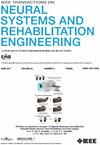基于线索掩蔽范式的快速准确的听觉注意方向和音色检测的脑电时空信息挖掘。
IF 4.8
2区 医学
Q2 ENGINEERING, BIOMEDICAL
IEEE Transactions on Neural Systems and Rehabilitation Engineering
Pub Date : 2025-04-01
DOI:10.1109/TNSRE.2025.3555542
引用次数: 0
摘要
通过脑电图对听觉注意进行解码,可以推断出用户在嘈杂环境中关注的是哪个源。解码算法和实验范式设计对于技术在实际应用中的发展至关重要。为了模拟真实场景,本研究提出了一种线索掩盖的听觉注意范式,以避免实验前的信息泄露。为了获得高解码精度和低延迟,提出了一种端到端深度学习模型AADNet,从脑电信号的短时间窗中挖掘时空信息。结果表明,在0.5 s脑电窗下,AADNet解码听觉方向注意(OA)和音色注意(TA)的平均正确率分别为93.46%和91.09%。它明显优于之前的五种方法,并且不需要了解原始音频源。研究结果表明,从脑电图信号中快速准确地检测听觉注意的方向和音色是可能的。研究结果为实时多属性听觉注意解码提供了理论依据,为神经导向助听器和其他助听设备的应用提供了理论依据。本文章由计算机程序翻译,如有差异,请以英文原文为准。
AADNet: Exploring EEG Spatiotemporal Information for Fast and Accurate Orientation and Timbre Detection of Auditory Attention Based on a Cue-Masked Paradigm
Auditory attention decoding from electroencephalogram (EEG) could infer to which source the user is attending in noisy environments. Decoding algorithms and experimental paradigm designs are crucial for the development of technology in practical applications. To simulate real-world scenarios, this study proposed a cue-masked auditory attention paradigm to avoid information leakage before the experiment. To obtain high decoding accuracy with low latency, an end-to-end deep learning model, AADNet, was proposed to exploit the spatiotemporal information from the short time window of EEG signals. The results showed that with a 0.5-second EEG window, AADNet achieved an average accuracy of 93.46% and 91.09% in decoding auditory orientation attention (OA) and timbre attention (TA), respectively. It significantly outperformed five previous methods and did not need the knowledge of the original audio source. This work demonstrated that it was possible to detect the orientation and timbre of auditory attention from EEG signals fast and accurately. The results are promising for the real-time multi-property auditory attention decoding, facilitating the application of the neuro-steered hearing aids and other assistive listening devices.
求助全文
通过发布文献求助,成功后即可免费获取论文全文。
去求助
来源期刊
CiteScore
8.60
自引率
8.20%
发文量
479
审稿时长
6-12 weeks
期刊介绍:
Rehabilitative and neural aspects of biomedical engineering, including functional electrical stimulation, acoustic dynamics, human performance measurement and analysis, nerve stimulation, electromyography, motor control and stimulation; and hardware and software applications for rehabilitation engineering and assistive devices.

 求助内容:
求助内容: 应助结果提醒方式:
应助结果提醒方式:


